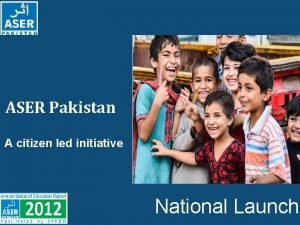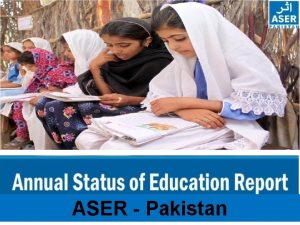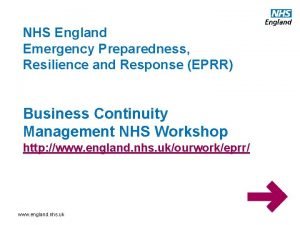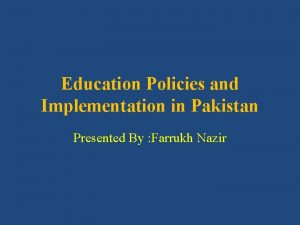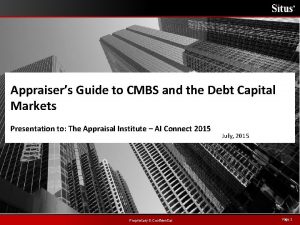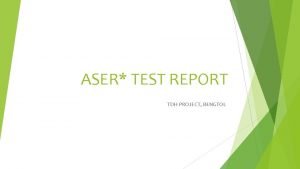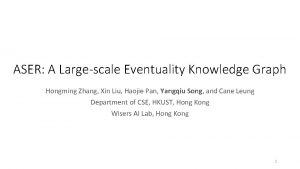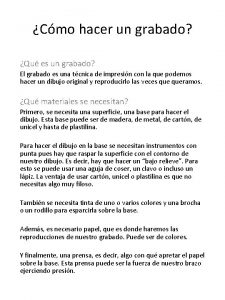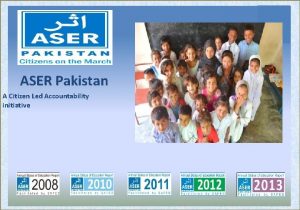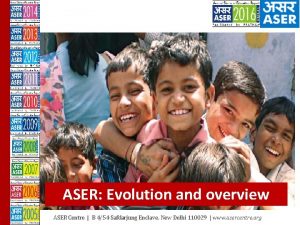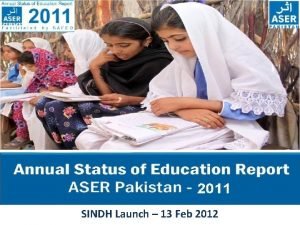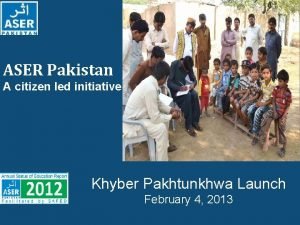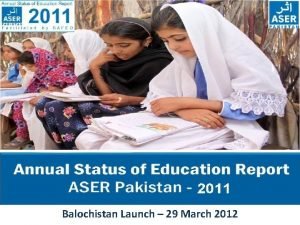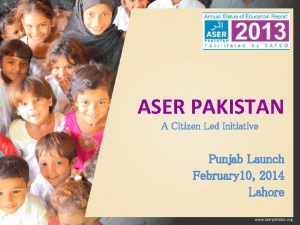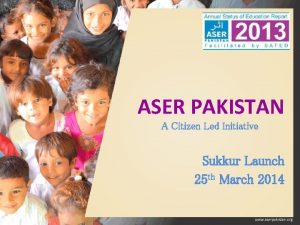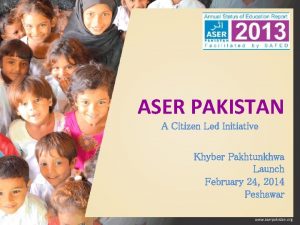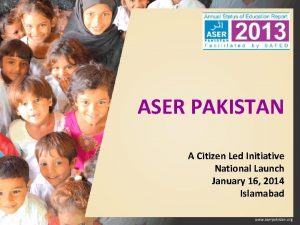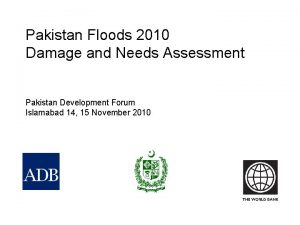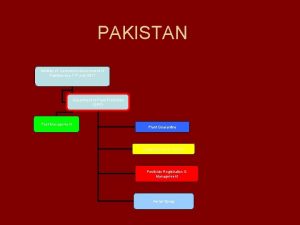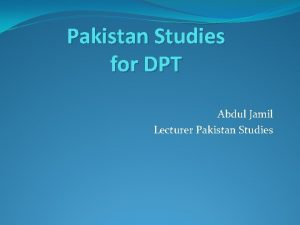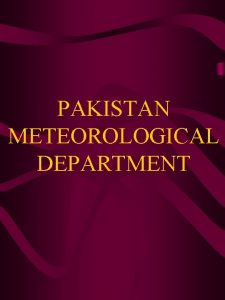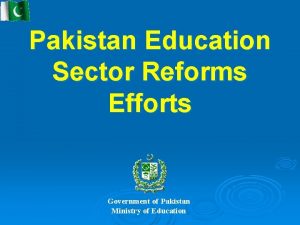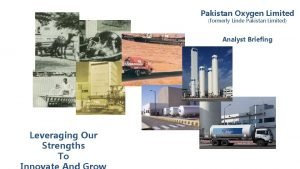ASER Pakistan ASER PAKISTAN 2010 2015 ASER The















































- Slides: 47

ASER - Pakistan

ASER PAKISTAN 2010 -2015 ASER - The Annual Status of Education Report (ASER) is a citizen led large scale national household survey about the quality of education in rural and some urban areas of Pakistan. Inspired by the ASER India & East Africa UWEZO methodology it seeks to fill a gap on learning outcomes by providing a reliable set of data at the national level on an annual basis, that is comprehensive and easy to understand. The survey’s objectives are three fold: Ø To get reliable estimates of the status of children’s schooling and basic learning (reading and arithmetic level) Ø To measure the change in these basic learning and school statistics from last year Ø To interpret these results and use them to affect policy decisions at various levels.

Scale & Scope of Survey Coverage : In all five provinces i. e. Sindh, Balochistan, Punjab, Khyber Pakhtoonkhwa, Gilgit Baltistan, and FATA & AJK. - Rural Phase I : Year I 2010 – 32 districts across Pakistan Phase II: Year II 2011 – 85 districts across Pakistan (84 Rural + 3 Urban /2 overlap with rural districts) Phase III : Years III, IV , V all districts across Pakistan (138 districts) Sample: 600 households per district. Two-stage stratified sample; 30 Villages will be selected randomly using the village directory of the latest Census. The Probability Proportional to Size Sampling (PPS) technique will be adopted as an appropriate one when the sampling units are of different sizes. 20 households per village and in each village 1 govt. and 1 private school are surveyed

ASER Pakistan – the Architecture Village Level 20 Houses per Village Master Trainers District Coordinator Provincial Coordinators ASER Associates SAFED /ITA Team Donors/ Development Partners Voluntary Surveyors (VSs) (CBOs, NGOs, Colleges, Universities) District Level 30 Villages per district Provincial Level Collaborating Partner Organizations (Master Trainers MT) & Volunteers 2011=85 Districts 2012 -2015 = All Pakistan National Level Chief Collaborating Partners (CCP) External Collaborators (ASER India, PCE, Experts/ Resource Persons)

ASER Calendar May Piloting of ASER Tools December June Identifying Partners July Preparing Survey Manuals November October Data Processing & Report Writing Survey & Recheck, Data Entry Training & Survey District Report Cards -/ Posters Designed (7) Coalition formation initiated August National Workshop September Training & Survey – ASER District Coordinators & Other Hiring Completed Information Dissemination - January– April Citizen-led Advocacy for Improving Learning Outcomes - All strands activated

Work Plan Sr. # Activity Pre Survey-Phase I: 1 Resource Mobilization – Partner Identification 2 Preparation of survey instruments/Tools 3 Partner Meeting Time line 4 Piloting of survey instruments August 1 -9, 2012 5 Review of Tools with Stakeholders August 10 -17, 2012 6 Finalization of Tools August 18, 2012 7 Training Course for ASER Associate September 11 -20, 2012 Lahore 8 9 Core Group Meeting ( Quarterly) Review & Printing of Tools + Logistics Survey-Phase II: National Workshop TOT – Balochistan District level trainings & survey- Balochistan Volunteer Training & Survey Gilgit- Baltistan TOT – Punjab , FATA & ICT Core Group Meeting ( Quarterly) District level trainings Survey Punjab – Punjab and ICT September 11, 2012 Lahore 17 18 19 20 21 22 23 24 10 11 12 13 14 15 16 April- June 2012 April - May, 2012 June 13, 2012 Location/ Lahore, Graham Yar Khan Sukkur, Quetta, and Peshawar NEAS, PEAS, IER, UOE, GCET August 7 -11, 2012 September 17 -19, 2012 September 18 -23, 2012 September 21 -23, 2012 October 3, 2012 Islamabad Quetta All ASER 2012 Districts Gilgit Islamabad / Lahore September 28 -30 & October 1, 2, 2012 All ASER 2012 Districts KP & Sindh – Provincial Workshop October 5 -7, 2012 KP & Sindh District level Training & Survey Data entry process Data cross checks Data crunching/analysis and writing Draft report for review by partners Core Group Meeting ( Quarterly) Report printing October 12 -16, 2012 October 1, 2012 October 2012 November 15, 2012 December 20, 2012 Peshawar & Hyderabad Lahore Lahore

Work Plan Sr. Activity # Pre Survey-Phase I: 1 Resource Mobilization – Partner Identification Time line Location/ April- June 2012 Post Survey-Phase III: 25 National release (Provisional Report) Punjab Release Sindh release 26 KP release Baluchistan release Gilgit – Baltistan Release 27 ASER Bathaks January 17, 2013 January 24, 2013 January 31, 2013 February 7, 2013 February 15, 2013 February 22, 2013 February – March, 2013 28 Core Group Meeting ( Quarterly) February 25, 2013 29 Policy Advocacy Jan- April, 2013 Islamabad Lahore Karachi Peshawar Quetta Gilgit All ASER 2012 Districts

ASER Pakistan Assessment Tools Grade II ASER Assessment tools are prepared in following Categories • Reading Urdu Sindhi Language • Arithmetic abilities • English


ASER Pakistan – the Architecture Village Level 20 Houses per Village Master Trainers District Coordinator Provincial Coordinators ASER Associates SAFED /ITA Team Donors/ Development Partners Voluntary Surveyors (VSs) (CBOs, NGOs, Colleges, Universities) District Level 30 Villages per district Provincial Level Collaborating Partner Organizations (Master Trainers MT) & Volunteers 2011=85 Districts 2012 -2015 = All Pakistan National Level Chief Collaborating Partners (CCP) External Collaborators (ASER India, PCE, Experts/ Resource Persons)

Section I : Scale of Survey

The PILOT Districts Villages Schools 11 326 283 House holds 6520 Children 16737

Districts Villages Schools 32 960 1297 House holds Children 19006 54062

Districts Villages Schools 87 2599 3642 House holds 49793 Children 146874

Districts Villages Schools House holds 144 4320 7000+ 86400 Children 250000+

Section II : Access?

Enrollment (6 -16 years) Ø 80% of 6 -16 year olds in rural districts are enrolled in schools Ø 74% enrollment in Govt schools Ø 26% Rural children enrolled in private/ non-state sector Ø 20% children are out of school ONE child Out of every FIVE Children is not in school


Inter-province Comparison Enrollment Ø Enrollment for boys higher as compared to girls in all provinces


Class Wise Enrollment Ø Enrollment decreases sharply as class level increases Class Wise Enrollment 2010* 2011 25 % Children 20 18. 5 15 16. 7 15. 2 10 14. 0 13. 3 11. 8 11. 6 12. 5 8. 6 12. 0 5 7. 9 7. 1 6. 5 6. 4 6. 3 0 1 2 3 4 5 6 Class 7 8 4. 9 4. 6 9 3. 7 3. 3 10

Enrollment - Urban ØGender Gap highest in Peshawar compared to Lahore & Karachi KARACHI LAHORE PESHAWAR Enrollment by Gender and Type of School 63. 2 52. 6 60 40 47. 4 36. 8 100 80 80 60 55. 3 44. 7 50. 6 49. 4 40 % Children 80 % Children 100 40 20 20 - - - Girls Govt School Boys Girls Pvt School Boys Girls Govt School Pvt School 64. 3 60 20 Boys 66. 3 33. 7 35. 7 Boys Girls Govt School Pvt School

Pre-School Enrollment (3 -5 Years) Ø Enrollment of children of 3 - 5 years 42% in 2011 Ø Enrollment highest in Karachi Urban (69%) compared to urban Lahore (59%) & Peshawar (41%) Action : Early years need the best investment – the foundation years for future learning. Special attention and resources needed to increase enrollment with trained teachers and safe learning environment.


Section III : Quality?

Learning levels – Urdu Std 2 level text ASER tools are created after analyzing textbooks As compared to other provinces, Punjab has the highest level of learning for Class 3 Urdu


Leaning levels – English Std 2 level text Ø Almost 59% of the children may complete primary without learning how to read fluently in English at grade II competencies


Basic Arithmetic levels Std 2 level Almost 63% of the children may complete primary without learning how to do division at grade II competencies


Learning levels – Public vs. Private Ø 55% children in government and 43% children in private schools in class 5 are still unable to read a class 2 level Urdu text Ø Almost 64% of the children in Government schools and 42% of children in private schools may complete primary without learning how to read fluently in English at grade II competencies Reading levels better in Private schools for Urdu, English and Arithmetic

Learning levels – Boys vs. Girls Learning levels better for boys in Urdu , English and Arithmetic

Learning Levels for Out of School Children • 18% of out-of-school children could read a sentence in Urdu.

Section IV : Private Supplementary Tuition?

Additional learning support Ø 7% Government and 24% Private enrolled children take tuition Rural


Section V : Attendance?

Attendance Ø Students “attendance as per register” (83%) higher compared to “attendance as per headcount” (80%) – Govt. schools ØOverall better attendance in Private sector

Section VI : Other dimensions that influence teaching and learning?

Mother’s Literacy Ø Percentage of Illiterate mothers: Mothers' Literacy Ø 34. 5% in Rural Districts. ØAs compared to Urban Lahore 34. 5% and Karachi, Urban Peshawar has the highest % of illiterate Literate Illiterate 65. 5% mothers (39%) Urban Literate Illiterate Lahore 76. 8 23. 2 Karachi 81. 5 18. 5 Peshawer 61. 1 38. 9


Basic Facilities – Toilet & Water 45% primary government schools still do not have useable water 57% primary government schools still no not have toilet facilities

Basic Facilities – Playground and Boundary Wall 63% primary government school have a boundary wall

Multi-grade Classes • Around 44% primary government schools children of class 2 sit with some other class and share teachers • What could cause this: Missing Teachers or lack of classrooms?

How can ASER 2011 inform the planning, drafting, resourcing and implementation of 25 A? Ø ASER can help assess education with respect to info. on: ØAccess ØQuality ØEquity ØPlanning according to district based assessment – generating District Report Cards (DRCs) linked to the Roadmap to Reforms initiative of the Govt. of Punjab. ØUse of ASER data and teams for advocacy on Right to Education – focusing on gender & the excluded groups ØForming District RTE Vigilante Committees mobilizing coalitions, teachers, youth, media and bar associations.

For more information visit: www. aserpakistan. org Email: safed@gmail. com
 Aser pakistan
Aser pakistan Aser pakistan
Aser pakistan Pas 2015 2010 and iso 22301
Pas 2015 2010 and iso 22301 Educational policy 1998 to 2010
Educational policy 1998 to 2010 Aser cmbs
Aser cmbs Programas de radio
Programas de radio Test aser
Test aser Aser
Aser Como aser qu
Como aser qu Thiếu nhi thế giới liên hoan
Thiếu nhi thế giới liên hoan Khi nào hổ mẹ dạy hổ con săn mồi
Khi nào hổ mẹ dạy hổ con săn mồi điện thế nghỉ
điện thế nghỉ Thế nào là sự mỏi cơ
Thế nào là sự mỏi cơ Một số thể thơ truyền thống
Một số thể thơ truyền thống Trời xanh đây là của chúng ta thể thơ
Trời xanh đây là của chúng ta thể thơ Số nguyên tố là gì
Số nguyên tố là gì Tỉ lệ cơ thể trẻ em
Tỉ lệ cơ thể trẻ em Phối cảnh
Phối cảnh Các châu lục và đại dương trên thế giới
Các châu lục và đại dương trên thế giới Thế nào là hệ số cao nhất
Thế nào là hệ số cao nhất Hệ hô hấp
Hệ hô hấp Tư thế ngồi viết
Tư thế ngồi viết Cái miệng bé xinh thế chỉ nói điều hay thôi
Cái miệng bé xinh thế chỉ nói điều hay thôi Hát kết hợp bộ gõ cơ thể
Hát kết hợp bộ gõ cơ thể đặc điểm cơ thể của người tối cổ
đặc điểm cơ thể của người tối cổ Cách giải mật thư tọa độ
Cách giải mật thư tọa độ ưu thế lai là gì
ưu thế lai là gì Tư thế ngồi viết
Tư thế ngồi viết Voi kéo gỗ như thế nào
Voi kéo gỗ như thế nào Thẻ vin
Thẻ vin Thơ thất ngôn tứ tuyệt đường luật
Thơ thất ngôn tứ tuyệt đường luật Các châu lục và đại dương trên thế giới
Các châu lục và đại dương trên thế giới Từ ngữ thể hiện lòng nhân hậu
Từ ngữ thể hiện lòng nhân hậu Diễn thế sinh thái là
Diễn thế sinh thái là Vẽ hình chiếu vuông góc của vật thể sau
Vẽ hình chiếu vuông góc của vật thể sau Thế nào là giọng cùng tên? *
Thế nào là giọng cùng tên? * 101012 bằng
101012 bằng Alleluia hat len nguoi oi
Alleluia hat len nguoi oi Lời thề hippocrates
Lời thề hippocrates Hươu thường đẻ mỗi lứa mấy con
Hươu thường đẻ mỗi lứa mấy con đại từ thay thế
đại từ thay thế Glasgow thang điểm
Glasgow thang điểm Quá trình desamine hóa có thể tạo ra
Quá trình desamine hóa có thể tạo ra Công thức tiính động năng
Công thức tiính động năng Thế nào là mạng điện lắp đặt kiểu nổi
Thế nào là mạng điện lắp đặt kiểu nổi Các loại đột biến cấu trúc nhiễm sắc thể
Các loại đột biến cấu trúc nhiễm sắc thể Bổ thể
Bổ thể
